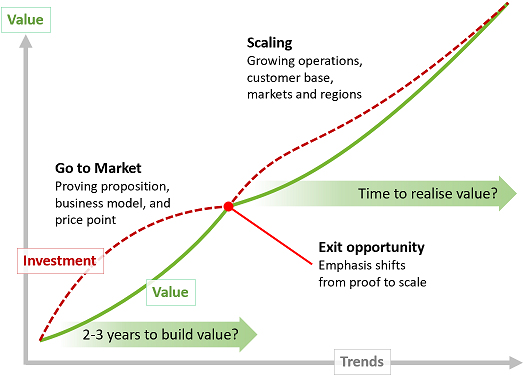Last Updated on
 External trends are the driver of opportunity – In particular, the timing of trends is a crucial factor determining how value is built. Crucial, too, because the conditions must be right when it’s time to realise the value, if that’s the objective.
External trends are the driver of opportunity – In particular, the timing of trends is a crucial factor determining how value is built. Crucial, too, because the conditions must be right when it’s time to realise the value, if that’s the objective.
Trends are all about external risks that you can’t control – As John Lennon is supposed to have said: “Life is what happens to you while you’re planning to do other things“. For the entrepreneur, those market trends happen around you while you’re grappling with the business of creating value – people, proposition, customers, channels, finances. A wise entrepreneur will have a keen eye on the trends that create the opportunity he’s after, and the all important timing of them.
Yesterday’s product tomorrow – Life moves on all the time, and markets wait for no one. You have to get that proposition to market, prove that it works and that people will buy it at a price that makes it worth doing; all that takes time. Those market trends had better not shift or run out of vibrancy before you get there, but that’s just the half of it, literally.
To make money from an asset, someone must buy it after you – An exit is just that: someone buying the asset after you, and the trends must still be favourable as the backdrop to any exit. So if you expect to take two to three years to build value, then the trends had better be reliable and positive for a good deal longer than that, so that the buyer can realise value, as well.
|
Primary Trends
|
What are the big, reliable long term trends?
There are six trends that I keep my eyes on – These exhibit strong characteristics that are likely to prevail over several decades. Most have been getting into their stride for some time. There may be others and I’d value the thoughts of anyone who has a keener eye than me.
Many other trends can be traced back to these – often short term openings made possible by these long term influences. It’s also worth noting that several of these are interconnected and tend to drive one another. There are handshakes between Climate Change and Water, and Demographics, Dehumanisation, and Digitalisation, for example. Each, though, is an independent and long-term trend.
These Primary Trends are firm reference points – entrepreneurs and strategist can look to them to validate an opportunity or to find a new angle on the market.
| Water: It is a slippery slope from water stress to water conflict. More than 4 billion people – half of humanity – experience severe water scarcity for at least one month a year. The Water Conflict Chronology, published by the Pacific Institute in Oakland, California, lists 279 instances of conflict over water since 2010. Read more |
These trends are driving behaviour today – They are opening up new business possibilities in the market, and beginning to close others. Anyone embarked on building value can benchmark their opportunity against these Primary Trends, and should be able to see whether their prospects are impacted. Few significant business opportunities will have no correlation with these trends, and it should be possible to sharpen the strategic view of timing and value. They should be driving behaviour in the Boardroom and the C-Suite.
Big trends drive big opportunities
Not only do these Primary Trends point to opportunities that are less likely to be swept aside in the general push and shove of business and competition, they indicate where the scale of opportunity lies, too. These are very large trends that are affecting global markets and populations. Hook on to one of these successfully, and it could run and run. These are not likely to play out any time soon.
| Demographics: By 2050, one in six people in the world will be over age 65 (16%), up from one in 11 in 2019 (9%). Regions where the share of the population aged 65 years or over is projected to double between 2019 and 2050 include Northern Africa and Western Asia, Central and Southern Asia, Eastern and South-Eastern Asia, and Latin America and the Caribbean. By 2050, one in four persons living in Europe and Northern America could be aged 65 or over. In 2018, for the first time in history, persons aged 65 or above outnumbered children under five years of age globally. The number of persons aged 80 years or over is projected to triple, from 143 million in 2019 to 426 million in 2050, says the UN in World Population Prospectus 2019. Read more |
Intersections enhance value – Leveraging the intersections between more than one trend is highly likely to raise the potential value of the opportunity considerably. These intersections give pause for thought, too.
The rise in automation and robotics, for instance, is often seen as threatening. Yet this trend is coinciding with the aging of the workforce, and the dwindling number of working age people compared to the ballooning numbers of elderly. Elsewhere, the digitalisation of agriculture is gathering immense speed, and improving productivity while reducing the inputs of chemicals, supporting care for the environment and climate change.
Decision makers and entrepreneurs must shoot ahead of the bird
Business is a journey in a moving landscape – Few in business today have a static environment to work in. It’s important for decision-makers to understand how the changing business environment and trends are moving, so that they can judge timing. Decisions take time to come to fruition: today will be yesterday, tomorrow.
If you want to exit then you must build the other guy’s dream – It’s hard to sell an opportunity that’s played out. You have too know where the trends are taking you, and what the world will look like when you reach the moment to exit.
Understanding the trends illuminates business – Decisions about the future can be more easily calibrated when the context is clear. Seeing over the horizon is vital when we’re navigating at speeds like this!
Further reading
 Blog The future began a while ago
Blog The future began a while ago
Blog Human engagement is a big opportunity
Blog Are humans the ultimate differentiator?
Peter is chairman of Flexiion and has a number of other business interests. (c) 2019, Peter Osborn .